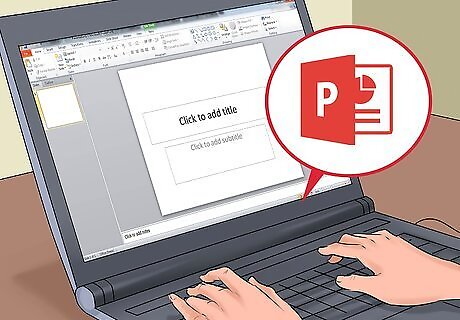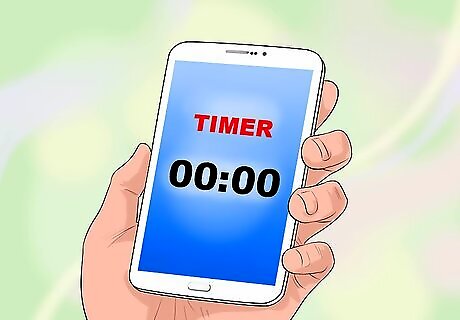
views
Making Your Initial Preparations

Understand the expected format. Seminars can come in a variety of forms. Talk with the organizer of the session and ask them about their expectations for your talk. They may want you to discuss a pre-circulated paper. Or, perhaps they would prefer that you give a speech with less audience interaction. You might ask, “Are you looking for a lecture format that is focused on research or a more interactive audience experience?” In most cases, plan to involve the audience through interactive activities. While the types of activities might differ, the involvement will help the audience participate.

Consider your audience. Know who you will be speaking to and tailor your information to their interest and experience levels. If you are unfamiliar with the group, ask the seminar organizer to give you a bit of information about the possible backgrounds of audience members. If you have worked with this group before, then use the information that you know about them to tailor your talk to what will help them, and you, the most. For example, in a scientific talk before a group of specialists, you may not need to explain all of your jargon and can jump into in-depth topics more quickly. Depending on your audience, you may also choose to directly engage with controversial topics or shy away from them. You can even get to the venue a bit early and try to talk with some audience members to get a better feel for the room prior to directing your seminar. You might ask one of the attendees, “What made you want to attend this particular seminar?” If you are in a professional setting, consider talking to some of the attendees ahead of time to see what they would like to learn.

Find out what technology is provided and what you need to bring. Make sure that you are comfortable using whatever technology is in the room. This may mean getting to know PowerPoint really well. Or, perhaps you need to practice how to switch slides using an automatic clicker or prompter. You may even want to give some thought to how you will set up the microphone, if you plan to use one. For example, if you are planning to use a slide presentation, then you’ll want to make sure that the room is equipped with a good projection system.

Create audience-friendly slides and visual aids. As you start to craft your presentation, think about whether or not your audience can actually interact with your visuals. For example, if you are using slides, then they need to be visible, clear, and easily readable. Use a large font and clear lettering. Stay away from too many extra graphics and include only minimal text. Be aware that it takes anywhere from 1-2 minutes for an audience member to read through a slide along with you. Therefore, don’t overload your presentation with slides or you will never finish. Instead, go with pictures that can accompany the information that you are providing directly to your audience. You can also use other visual styles, such as models, posters, flyers, or brochures. Don’t feel forced into sticking with slides and instead consider dipping into your creative side, if the seminar format supports this.

Circulate any materials in advance, if needed. If your seminar will focus on a paper discussion, it is a good idea to work with the organizer to get a copy of the paper out to potential audience members at least a few days before the meeting. This will allow audience members to come prepared with advanced questions and comments. It will also let you dive into deeper material right away, as you can assume a certain level of common knowledge. If the paper that you circulate is a work in progress, you might say so on the draft itself and then repeat this at the start of your seminar. This way audience members will know that you welcome constructive criticism and other ideas.

Practice giving your seminar using your outline. Once you have an outline in place and your visual materials prepared, you will want to practice as often as possible. Ask your friends, family members, colleagues, or mentor to serve as mock audience members for a trial run. Videotape yourself and then play it back, so that you can identify areas of improvement. Practice until you feel totally comfortable with the material and process. After each practice session, make notes on the sections that are working well and those that still need some refining.

Arrive to the seminar location early. It is a good idea to get to the seminar room a little early, so that you can see how the room is set up. You can also upload your presentation and pass out any handouts or brochures. This also gives you a last minute opportunity to meet with the seminar organizer to iron out any issues. If you arrive 15-30 minutes beforehand that is usually enough time to accomplish everything that you need to do prior to starting the session. If it is a large seminar or a seminar that relies heavily on technology, you might consider arriving up to an hour early.
Managing Your Content

Introduce yourself. Start off your seminar by going to the podium, or just the front of the room, and providing a full introduction. Tell the audience a bit about your professional background. Briefly explain why you are interested in the project that you will be discussing today. This is intended to make the audience comfortable listening to you and to start building the speaker-audience trust. Be humble as you introduce yourself, but stress your credibility in this subject. Instead of assuming that you know more about your audience, just let them know what experience you have. If someone else introduced you, make sure that they have a copy of your biography in advance. Bring an extra copy with you. When it's time for you to speak, you might say a few quick words about your passion for this project and offer your thanks to the organizers for the opportunity to speak with your audience today.

Follow an outline of speaking points. Your talk should move from one logical point to another. Even if you have the entire talk memorized, it might be useful to have a paper with talking points or notecards in front of you. This may also help with your pacing. A good rule of thumb when giving a seminar is to, “Tell them what you will tell them, tell them, tell them what you told them.” For example, if you are giving a seminar focusing on a chronological topic, such as the development of the U.S. Civil War, make sure to give your audience plenty of warning before you jump time periods.

Give content outside of your visual aids. It can be very tempting to read directly from your slides but try to resist the urge! Instead, gesture to your slides as support for the larger points that you are making. If you’ve practiced enough, your progress with the slides will also let you know if you are making good time. For example, if you have a slide with a photo of Lincoln, then you could build upon that by discussing his time in office or his personal background. This information doesn’t need to be spelled out alongside the image. Print out a copy of your slides and keep it in front of you as you speak. This will remind you which slide is coming up next so that you can smoothly transition to the next point.
Introduce an interactive portion. To keep the audience's attention and to help them learn, make sure that they are involved with the material. Games, discussions, quizzes, and surveys will help them participate in the seminar. An icebreaker activity at the beginning of the seminar helps lighten the mood and grab people's attention. You can break up large groups into small groups to have them discuss a problem, question, or point.

Stick to the time allotted. As soon as you agree to do the seminar, find out what your time restrictions will be and design your presentation around these. Aim for a presentation that falls at the exact time or just under the time limit. Never go over time. If you find yourself at the time limit, then find a quick way to wrap up and offer to explain more during the question session. For example, you might say, “Well, I’ve reached the end of my time, but I would love to talk about any of these issues in response to any questions that you have.”

Answer all questions as completely as possible. Start by repeating the question to ensure that the entire audience can hear what is being discussed. Then, take a moment to compose your response before jumping in, if necessary. Try to link your answer back to your overall presentation whenever possible, perhaps adding information that you were unable to include due to time or format restrictions. When planning your seminar, make sure to leave time at the end to answer questions. Prepare a short statement to wrap up the talk after the Q&A session is over. Try to thank each person for their question after answering it. If a particular person tries to dominate the question session, you can offer to speak with them after. If you don’t know the answer to a particular question, it is okay to say, “That is an excellent question, but I do not have that exact information.”
Projecting Confidence and Expertise

Maintain steady and consistent eye contact. Look around the room as you are speaking and try to make eye contact with almost everyone in the room throughout your presentation. If you find yourself gazing at just one part of the room, force yourself to look in the other direction. Similarly, don’t just focus on the back of the room, look at actual people so that you can gauge their responses to what you are saying.

Speak clearly and with authority. From your video practice sessions, you will notice if your voice wavers or cannot carry far enough. Try to project your voice out, so that you can speak without a microphone, if necessary. Also, go slowly and carefully pronounce each word so that everyone can understand what you are saying. It might help to write, “Speak clearly,” in the margins of your presentation notes. This will remind you to keep up your voice mid-presentation. To practice projecting your voice, stick your tongue all the way out and say a nursery rhyme, like Humpty Dumpty. Afterward, say the same rhyme normally. You'll notice that you can project your voice more clearly after doing this exercise.

Keep your calm after an error. If you make any mistakes while speaking, odds are your audience didn’t even notice. But, if you are worried, then you can acknowledge your error very quickly before moving right back into your presentation outline. This is yet another opportunity to build trust with your audience. For example, you might say, “I just noticed that that figure in column 3 is not up to date as of today, so the more accurate number would be…”

Control your body language. Keep your arms and hands under control and avoid fidgeting with a pen or other item. Watch your walking patterns and try to move a bit, but not enough to be distracting. As you are analyzing your body language, consider whether or not your actions will distract from your content and, if they do, try to minimize or eliminate them. To help transition between points, move to another part of the room or change places when you move through certain points. If you want to emphasize a point, stop your body completely. Plant your feet together and take a pause before saying the sentence.


















Comments
0 comment